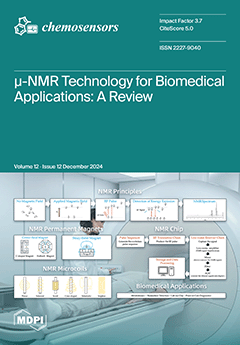We have found that the dye 1,3,3-trimethyl-2-((1′E,3′E,5′E)-5’-(1″,3″,3″-trimethylindol-(2′E)-ylidene)-penta-1″,3″-dien-1″-yl)-3
H-indol-1-ium (
DTMI-5) can be successfully used for the simple green determination of H
2O
2 and Fe(III)/Fe(II) species. The dye is characterized by a successful combination of spectral, protolytic, and redox properties,
[...] Read more.
We have found that the dye 1,3,3-trimethyl-2-((1′E,3′E,5′E)-5’-(1″,3″,3″-trimethylindol-(2′E)-ylidene)-penta-1″,3″-dien-1″-yl)-3
H-indol-1-ium (
DTMI-5) can be successfully used for the simple green determination of H
2O
2 and Fe(III)/Fe(II) species. The dye is characterized by a successful combination of spectral, protolytic, and redox properties, and the process of its decolorization in the Fenton reaction is monitored using an optical immersion probe. Theoretical calculations of the reactive sites in the
DTMI-5 molecule under free radical attack reveal that the methine groups of the penta-1′,3′-dien-1′-yl linker serve as the primary reactive centers in Fe
3+ or Fenton-type oxidation conditions. Density functional theory (DFT) calculations indicate that the redox potentials of the examined structures range from 0.34 to 1.65 eV. The experimentally observed broad peak at 340–360 nm, which appears after the interaction of
DTMI-5 with the Fenton reagent, is attributed to the formation of aldehyde-type oxidation products, whose theoretical CIS(D) absorption maxima were 358.1 and 337.4 nm. The influence of various factors on the course of the reaction was experimentally investigated. The most important analytical characteristics of the methods, such as linearity intervals of calibration graphs, precision, LOD and LOQ values, selectivity coefficients, etc., were determined. The developed methods were applied to model and real samples (water, oxidation emulsion, and fertilizer).
Full article





